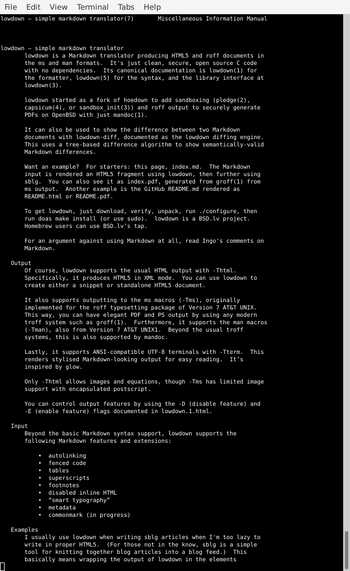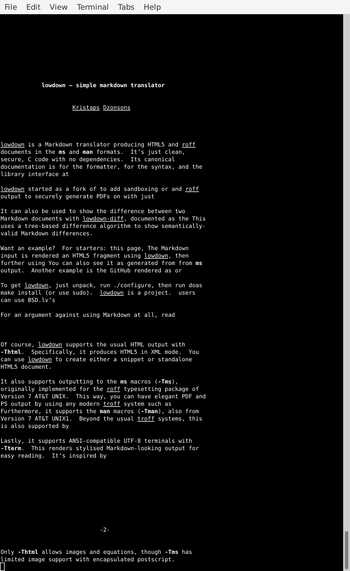lowdown — simple markdown translator
lowdown is a Markdown translator producing HTML5, roff documents in the ms and man formats, LaTeX, gemini (“gemtext”), OpenDocument, and ANSI/UTF8 terminal output. The open source C source code has no dependencies.
The tools are documented in lowdown(1) and lowdown-diff(1), the language in lowdown(5), and the library interface in lowdown(3).
To get and use lowdown, check if it’s available from your system’s package manager. If not, download, verify, and unpack the source. Then build:
% ./configure
% make
% make regress
# make install install_libs
On non-BSD systems, you may need to use bmake.
lowdown is a BSD.lv project. Its portability to OpenBSD, NetBSD, FreeBSD, Mac OS X, Linux (glibc and musl), Solaris, and IllumOS is enabled by oconfigure.
One major difference between lowdown and other Markdown formatters it that it internally converts to an AST instead of directly formatting output. This enables some semantic analysis of the content such as with the difference engine, which shows the difference between two markdown trees in markdown.
As of version 2.0.0, lowdown uses semantic versioning (“semver”). A major number change indicates a change in the lowdown(3) API, a minor number indicates a change in functionality, and a patch number indicates a bug-fix or change without functionality. The version 2.0.0 reflects API changes in 1.4.0 that preceded.
Output
lowdown produces HTML5 output with -thtml, LaTeX documents with -tlatex, “flat” OpenDocument (version 1.3) documents with -tfodt, Gemini (“gemtext”) with -tgemini, roff documents with -tms and -tman, or directly on ANSI terminals with -tterm.
The -tlatex and -tms are commonly used for PDF documents, -tfodt for document processing, -tman for manpages, -thtml or -tgemini for web, and -tterm for the command line.
By way of example: this page, index.md, renders as index.latex.pdf with LaTeX (via -tlatex), index.mandoc.pdf with mandoc (via -tman), or index.nroff.pdf with groff (via -tms).
-tman -tterm -tms
Only -thtml and -tlatex allow images and equations, though -tms has limited image support with encapsulated postscript.
Input
Beyond traditional Markdown syntax support, lowdown supports the following Markdown features and extensions:
- autolinking
- fenced code
- tables
- superscripts (traditional and GFM)
- footnotes
- disabled inline HTML
- “smart typography”
- metadata
- commonmark (in progress)
- definition lists
- extended attributes
- task lists
- admonitions
- templating
Examples
Want to quickly review your Markdown in a terminal window?
lowdown -t term README.md | less -R
If you just want a straight-up HTML5 file, use standalone mode:
lowdown -s -o README.html README.md
This can use the document’s meta-data to populate the title, CSS file, and so on.
The roff ms macros work to make PS or PDF files. The extra groff arguments in the following are for UTF-8 processing (-k), tables (-t), and clickable links and a table of contents (-mspdf).
lowdown -s -t ms README.md | pdfroff -itk -mspdf > README.pdf
The same can be effected with systems using mandoc through the simpler man macros.
lowdown -s -tman README.md | mandoc -Tpdf > README.pdf
More support for PDF (and other print formats) is available with the -tlatex output.
lowdown -s -tlatex README.md | pdflatex
Read lowdown(1) for details on running the system.
Library
lowdown is also available as a library, lowdown(3). This is what’s used internally by lowdown(1) and lowdown-diff(1).
Testing
The canonical Markdown tests are available as part of a regression
framework within the system. Just use make regress to run these and
many other tests.
If you have valgrind installed, make valgrind
will run all regression tests with all output modes and store any leaks
or bad behaviour. These are output to the screen at the conclusion of
all tests.
The CI runner in lowdown’s GitHub repository runs both valgrind and regular regression tests, the latter with the compiler’s -fsanitize options enabled, on each push.
I’ve extensively run AFL against the compiled sources with no failures—definitely a credit to the hoedown authors (and those from whom they forked their own sources). I’ll also regularly run the system through valgrind, also without issue. The afl/in directory contains a series of small input files that may be used in longer AFL runs.
Code layout
The code is neatly layed out and heavily documented internally.
First, start in library.c. (The main.c file is just a caller to the library interface.) Both the renderer (which renders the parsed document contents in the output format) and the document (which generates the parse AST) are initialised.
The parse is started in document.c. It is preceded by meta-data parsing, if applicable, which occurs before document parsing but after the BOM. The document is parsed into an AST (abstract syntax tree) that describes the document as a tree of nodes, each node corresponding an input token. Once the entire tree has been generated, the AST is passed into the front-end renderers, which construct output depth-first.
There are a variety of renderers supported: html.c for HTML5 output, nroff.c for -ms and -man output, latex.c for LaTeX, gemini.c for Gemini, odt.c for OpenDocument, term.c for terminal output, and a debugging renderer tree.c.
Installing
You’ll need a C compiler with essential build tools
(make, cc,
etc.). On non-BSD systems, you may need to use bmake. First,
configure the system:
./configure
You can pass variables like PREFIX and such here. To install the binaries, run:
make install
For libraries, you can additionally run:
make install_libs
This may be split into install_shared and install_static for shared
and static libraries, respectively.
Example
For example, consider the following:
## Hello **world**
First, the outer block (the subsection) would begin parsing. The parser would then step into the subcomponent: the header contents. It would then render the subcomponents in order: first the regular text “Hello”, then a bold section. The bold section would be its own subcomponent with its own regular text child, “world”.
When run through the -Ttree output, it would generate:
LOWDOWN_ROOT
LOWDOWN_DOC_HEADER
LOWDOWN_HEADER
LOWDOWN_NORMAL_TEXT
data: 6 Bytes: Hello
LOWDOWN_DOUBLE_EMPHASIS
LOWDOWN_NORMAL_TEXT
data: 5 Bytes: world
This tree would then be passed into a front-end, such as the HTML5
front-end with -thtml. The nodes would be appended into a buffer,
which would then be passed back into the subsection parser. It would
paste the buffer into <h2> blocks (in HTML5) or a .SH block (troff
outputs).
Finally, the subsection block would be fitted into whatever context it was invoked within.
Compatibility
lowdown is fully compatible with the original Markdown syntax as
checked by the Markdown test suite, last version 1.0.3. This suite is
available as part of the make regress functionality.
There are many other extensions to Markdown implemented in lowdown: see the manpages for specifics.
How Can You Help?
Want to hack on lowdown? Of course you do.
Using a perfect hash (such as gperf) for entities.
RTL languages are totally unrepresented. It’s difficult but not impossible to refactor term.c to internally create a sequence of lines, instead of a stream of contiguous output, allowing for a post-processing RTL pass.
There are bits and bobs remaining to be fixed or implemented. You can always just search for
TODO,XXX, orFIXMEin the source code. This is your best bet.If you want a larger project, a -tpdf seems most interesting (and quite difficult given that UTF-8 need be present).
Implement a parser for mathematics such that
eqnor similar may be output.
Coverage
The regression suite executes the lowdown code in many ways. It’s
easy to track this by examining run-time coverage using
gcov (or the clang
alternative). To examine how the regression suite covers the sources,
run make coverage. The current coverage is as follows:
| Files | Coverage |
|---|---|
| autolink.c | 65.73% |
| buffer.c | 72.15% |
| diff.c | 79.40% |
| document.c | 81.46% |
| entity.c | 75.31% |
| gemini.c | 65.87% |
| gemini_escape.c | 76.19% |
| html.c | 74.91% |
| html_escape.c | 87.65% |
| latex.c | 64.82% |
| latex_escape.c | 65.38% |
| library.c | 80.14% |
| libdiff.c | 94.05% |
| nroff.c | 74.72% |
| nroff_escape.c | 84.00% |
| odt.c | 64.34% |
| smartypants.c | 83.89% |
| template.c | 78.83% |
| term.c | 71.73% |
| tree.c | 37.21% |
| util.c | 66.13% |


